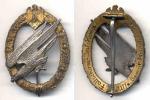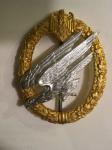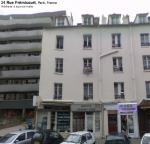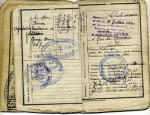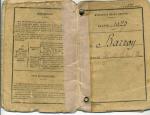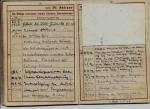-
Posts
2,284 -
Joined
-
Last visited
-
Days Won
6
Content Type
Profiles
Forums
Blogs
Gallery
Events
Store
Everything posted by PKeating
-

Heer Fake Army Parachutist Badges
PKeating replied to PKeating's topic in Wehrmacht Medals, Decorations & Awards
-

Heer Fake Army Parachutist Badges
PKeating replied to PKeating's topic in Wehrmacht Medals, Decorations & Awards
Wrong image but, hey, it won't do you any harm to keep looking at genuine badges before we get to the various fakes out there. -

Heer Fake Army Parachutist Badges
PKeating replied to PKeating's topic in Wehrmacht Medals, Decorations & Awards
Another view of the reverse of a Type 2a badge. This example has a period repair to the hook and a re-anodised wreath. The first form pin is more distinct here, its rounded, blunt end protruding below the bottom of the wreath like the pins on the Type 1 badges. -

Heer Fake Army Parachutist Badges
PKeating replied to PKeating's topic in Wehrmacht Medals, Decorations & Awards
Here are the three basic types of aluminium badge, excluding the 'transitional' badge. Note how the Type 2a badge in the middle has the same type of hinge and pin assembly as that of the Type 1. The outer parts of the hinge, made of the same aluminium as the rest of the badge, are spaced wider apart than those of the Type 2b badge on the bottom. The blued steel Type 2a pin is also the same as the Type 1 pin, whereas the pin on the Type 2b badge is turned to a point. The wreaths are all struck on the same set of dies, the differences being that the edges of the wreaths of the Type 2 badges are hand-chased to a far greater extent with fine files to accentuate the silhouettes of the leaves and acorns. Note the 'beard' under the beak of the national eagle on Type 2 badges. Not visible here is the greater thickness of the Type 2b wreath, evidently achieved by adding a shim to the dies, which would have been a simple solution given that the outer edges were straight before the hand-finishing stage. -

Luftwaffe Army Paratroopers Badges-Engraved
PKeating replied to shaneos3's topic in Wehrmacht Medals, Decorations & Awards
Just a side note: that is a Type 2a, with the same wide hinge configuration as the Type 1 badges. The Type 2b was struck on the same dies but had a thicker wreath with minor detail changes, including the hinge layout and the pin. I'll leave the question regarding '206' open. Bob: do you mind if I use this alongside other Type 2a badges in the guide I am putting together over in the Heer section? http://gmic.co.uk/index.php?showtopic=40262 PK -

Heer Fake Army Parachutist Badges
PKeating replied to PKeating's topic in Wehrmacht Medals, Decorations & Awards
A slightly clearer image showing the die flaw in question on the private purchase .800 silver badge owned by Georg Knacke. We shall also be discussing the silver badges in due course. While there has been no serious attempt so far to fake the Type 1 badges, I have heard of people rejecting perfectly genuine 'finds' because they did not resemble the Type 2 badges with which most collectors are far more familiar, because while they are very rare, the Type 1 badges are extremely rare and, paradoxically, these 'transitional' variants are the rarest of all. I have never understood how a posh firm like C E Juncker allowed these out of their workshops. I suppose it might be understandable in the case of a batch of issue aluminium badges with the flaw but in the case of fairly expensive solid silver 'bling' like this? But there we are. They did and, as a result, you are now looking at one of the rarest of Third Reich military badges. -

Heer Fake Army Parachutist Badges
PKeating replied to PKeating's topic in Wehrmacht Medals, Decorations & Awards
A Type 1 Transitional badge, showing the ugly flaw on the talons as a result of the attempted revision of the die to beef up the talons. I have seen one of these 'transitional' badges with the 'beard' of die-flashing under the national eagle's beak, as seen on Type 2 badges. -

Heer Fake Army Parachutist Badges
PKeating replied to PKeating's topic in Wehrmacht Medals, Decorations & Awards
A more detailed view of the Type 1 badge on the left, which used to be in my collection and now resides with Eric Queen, who just joined GMIC and will, hopefully, be showing us some very nice stuff. Because of the patina or tarnishing on the reverse of the eagle, the hallmark is all but invisible but we will be discussing hallmarks later. This is the only known aluminium issue badge with the same kind of factory engraving encountered on all but one of the known, surviving .800 silver badges offered for private purchase by C E Juncker to men who could prove their entitlement to the badge, either with their award document or military parachutist licence. The catch is broken, as on many of these aluminium badges, because it was made of the same very fine but fragile high grade aluminium. Note the blued pin, the flat-topped conical rivets, the finish, the overall quality of the strike and all the other details underscoring the overall quality and finesse of this badge. Study the surface details of the wreath. If the wreath of any Army Parachutist Badge you are are thinking of buying does not conform precisely to what you see here, the badge is a fake because C E Juncker was the only firm that supplied these badges and they used the same obverse die in 1937/38 and 1943/44. The back of the head of the national eagle has suffered a knock at some point. Note how the finisher has done his best to file away the die-flashing. With this in mind, look at the talons of the diving eagle and imagine not just how time-consuming the file-chasing process was but now many must have broken off during the finishing process. This led to the complete redesign of the eagle but not before the firm tried to modify the die, resulting in what we call the "Type 1 transitional badge". -

Heer Fake Army Parachutist Badges
PKeating replied to PKeating's topic in Wehrmacht Medals, Decorations & Awards
On the left, we have the classic Type 1 badge, struck in aluminium by C E Juncker. This particular badge graces the cover of Eric Queen’s book Red Shines The Sun and is sometimes described as “the extended talons type”. Note the anodised gold finish, imparting a matt appearance to the wreath. The eagle was silver-frosted with polished nighlights and bore the firm’s hallmark on the reverse, as we shall see later. These badges were made in 1937 and awarded to members of the Fallschirm-Infanterie-Kompanie In the middle is a classic Type 2 badge in aluminium. In fact, this is what we refer to as the Type 2b badge, because the wreath was made thicker, for greater strength, by adding a shim to the die. The edges of the wreath are chased to a far greater extent than on the Type 1, although the same dies were used. The diving eagle is the most noticeable difference. The reasons for the redesign will become apparent later. Note the lack of an attempt to remove the die-flashing under the beak of the national eagle, compared to the Type 1. There are other detail differences but these will be discussed later. Only a few of these Type 2 badges are known with the C E Juncker hallmark. These Type 2 badges were made in 1938 and awarded to members of the Fallschirm-Infanterie-Bataillon. On the right is the Type 3 badge reinstituted in 1943 for members of the Brandenburg parachute units, namely 15. (Fallschirm) Kompanie and, later on, in 1944, Fallschirmjäger-Bataillon “Brandenburg”. A few members of SS-Fallschirmjäger-Bataillon 500 received these badges, as a handful of surviving paybooks and documents show but most went to the Brandenburgers, which gives some idea of the small production runs involved. The badge was struck in feinzink by C E Juncker on the same dies as the prewar Type 2 badges. These wartime examples have no hallmarks and tend to retain their finish surprisingly well for mid to late-war zinc items. PK -
As people are still buying fakes of these badges in the belief that they are getting amazing bargains for half or two-thirds of the price they might pay for the genuine article, it seems logical to start a topic featuring authentic examples and the various fakes, some of which have been out there for more than thirty years. Sincere questions, comments and contributions are welcome but please, if you have a badge you have seen on eBay or some such site and wish to know more about it, start a separate topic as the aim of this topic is for serious students of the subject to be able to help less experienced people avoid the pitfalls. To begin with, let's look at the three basic types of genuine Army Parachutist Badges.
-

Luftwaffe Army Paratroopers Badges-Engraved
PKeating replied to shaneos3's topic in Wehrmacht Medals, Decorations & Awards
I think the screenshot posted by Eric came from a www.gunbroker.com auction some time ago. I think I will start a rogues' gallery of fake Army Para Badges, since people are still getting clipped by the various fakes in circulation out there. Keep an eye on the relevant Heer badges section. PK -
Interesting to see the rank rings of tresse on the sleeve of Hauptmann Prager's jump smock, a system reprised for junior leaders in the early days of SS-Fallschirmjäger-Btl 500, when many of fellows there were banned from wearing medals and insignia of any kind because of their disciplinary status. Thank you very much, Eric, for posting both the photo of Prager and of Hermann Reil. Regarding the rank rings, this was not the only example of the prewar Fallschirm-Infanterie Kompanie/Bataillon being a bit of a law unto themselves where insignia was concerned, as the photos of other officers wearing the 1938 new-style field caps or 'sidehats' with the BeVo wreaths and cockades from the old-style field caps show. Are there any other documents from Hermann Reil known to survive? PK
-

EK 1914 1914 EK1 With Clamshell Screwback
PKeating replied to DavidM's topic in Germany: All Eras: The Iron Cross
Seems to be a fairly classic 3rd Reich era example - someone else here will probably be able to tell us who made it - that could have been lightly vaulted by its owner. I have had real vaulted 1914 EK1 with LDO hallmarks and they are as vaulted as their 1914-1920 counterparts. It is a nice cross and a very good catch as screwback WW1 EK1 from the WW2 era are not so common. PK -
The Association for the Patronage of Orphans of Both Sexes was founded by Imperial Decree on 7.8.1867 (by the Emperor Napoleon III), as the legend on the obverse says. This medal was presented to Fernande Fanton in 1911. Monsieur Fanton had clearly assisted the association in some way that merited this medal. It is official in that it is a medal awarded by a body set up by order of the Emperor and might have been worn on a ribbon around the recipient's neck just after the award but in general, such medals were presented in cases and thereafter treated as non-portable awards, usually residing in glazed cabinets or frames in recipients' offices or homes. There is a very active collecting scene focusing on the many types of medals of this general type here in France. Hope this helps. Hope to meet you on one of my regular sojourns there in my home town. PK
-
Thanks, Paul. Very kind of you. I've seen this cross in a few medal shops and on a few blazers. Odd-looking thing. You're absolutely right, Chris. The ORA/FFI entries were also verified by the veterans' association or amicale after the war, and Barroy remained on the reserve until 1953. The Croix de Combattant Volontaire de la Résistance was not instituted until 1954 so some of the entries for the medals were certainly made afterwards. There is a teacher in Le Mans who has published a book of photographs of some 200 members of the sarthois resistance, in which Barroy is included so I am going to order it. I would have thought that Barroy was entitled to some other medals too, like the 1939-1945 War Medal with the LIBÉRATION clasp and the ordinary Resistance Medal. Anyway, there must be files on him and on his ORA unit and their actions. PK
-
The house at 22 rue Frémicourt, in the south-west of Paris, in the 15th arrondisement, where Lucien Borroy grew up. I must take this opportunity to thank Chris Boonzaier for alerting me to this extraordinary military paybook belonging to a young aviator in the 1920s who went on to be quite an important Resistance commander. There is more research to be done. Having found references to a couple of previous eBay sales, I know that there are more documents relating to Lucien Borroy's military and resistance careers and that the group was split up by someone, which is regrettable. Some vendors do this through greed and others through ignorance but I think one has to be quite stupid to split up groups, unless they are so expensive as to render it impossible to sell in one go, which happens. L'Organisation de résistance de l'armée was established in January 1943 after the German invasion of Vichy France in November 1942. However, a number of Pétain's generals and other high-ranking officers of the Armée d'armistice had been planning it since July 1940. The ORA consisted of French veterans who described themselves in the main as apolitical but who were anti-Gaullist. Many of the members tended to be sympathetic towards General Giraud, who had not yet thrown his lot in with de Gaulle. The prime mover in the founding of the ORA was General Frère, who had presided over the tribunal that condemned Colonel de Gaulle to death in August 1940 for desertion. In the former «Zone libre», the ORA was given supplies and arms by the Pétainist armée d'armistice who had managed to retain a lot of weapons despite German requests to hand them over. While the ORA responded to the call from London to ally itself with the Armée secrète and the FTP in February 1944, the organisation retained its sense of autonomy. The ORA was also active in the former Occupied Zone, which is where Borroy and his unit operated. By the end of hostilities, the ORA had lost more than 1,600 men, including 327 officers and NCOs in action or through summary execution by their captors. More than 850 were sent to concentration camps, of whom 360 did not return. PK
-
The pages showing his periods of service and his decorations and medals. As Paul L Murphy says in another thread about the medals listed, some of them are semi-official or unofficial medals rarely seen entered in an official livret militaire. Barroy received the Colonial Medal with MAROC clasp for his service there in 1925 and 1926 and also qualified for the Combattant's Cross, as well as the 1939-1945 Combattant's Cross for the War of 1939-1940. As a side note, this was one of the two decorations reissued by the Vichy government with the 1939-1940 dates, the other being the 1939 Croix de Guerre. Barroy did not receive the Croix de Guerre but he did receive the Combattant's Cross for Resistance Volunteers, instituted in 1954, which was quite a prestigious decoration.
-
As Page 4 shows, under the entry for the 1937 summer training period, l'aspirant Barroy - aspirant being a rank equating to an officer cadet or potential officer - is called up in August 1939 and posted to Airbase 102 near Dijon. This airbase still exists and is considered the home of the French air force, where the first squadron was formed in 1914. In the 1930s, BA 102 was home to various fighter and reconnaissance squadrons. In July 1940, after the Armistice, Barroy is at BA 109 near Tours. He is demobilised at Châteauroux on 31.7.1940 and returns home to Château du Loir wherehe becomes active in the Resistance in March 1944. Barroy is listed as a Lieutenant of the FFI or Forces françaises de l'intérieur on 2.6.1944, operating as the commander of the Groupe armée 7 or the L'Organisation de résistance de l'armée for quite a large area bordered by Tours, Angers and Le Mans, hence the stamps bearing the legend ORA-TAM. The entries also bear a postwar stamp as verification and validation. Lieutenant Barroy's resistance pseudonym was "Ali Baba".
-
In the summer of 1937, Monsieur BARROY Lucien is called up for some reserve training. This was tucked into the paybook. The summons is redirected from his family home at 12 rue Frémicourt, Paris 15 to 1 rue Recollet, Château du Loir, about 40 km south of Le Mans, in the Sarthe region.
-
Pages 2 and 3. Born in Paris on 27.2.1909, Lucien Barroy was an ajusteur mécanicien when he joined the 32e Régiment d'Aviation on 10.5.1925, aged just sixteen. Le soldat 2e classe Barroy was posted to Morocco in September 1925, to the 14e Éscadrille at Sidi-Djellil, near the town of Taza, which is about 100 km due east of Fés, where he spent a year. The Berber chieftan Abd El-Karim had invaded French Morocco in April 1925 and Paris had dispatched an expeditionary force under the command of Marshal Philippe Pétain, which fought side-by-side with Spanish forces against the armed forces of Abd El Karim's Rif Republic. The squadrons of the 32nd Air Regiment flew many bombing and strafing sorties during the ten month war and civilians were considered valid targets by Franco-Spanish forces using a wide range of weapons, including mustard gas. Abd El-Karim surrendered to the French on 26.5.1926. Judging by the photograph in his paybook, Barroy seems to have been on flying duties. He was repatriated on 13.9.1926 and sent on leave.
-






